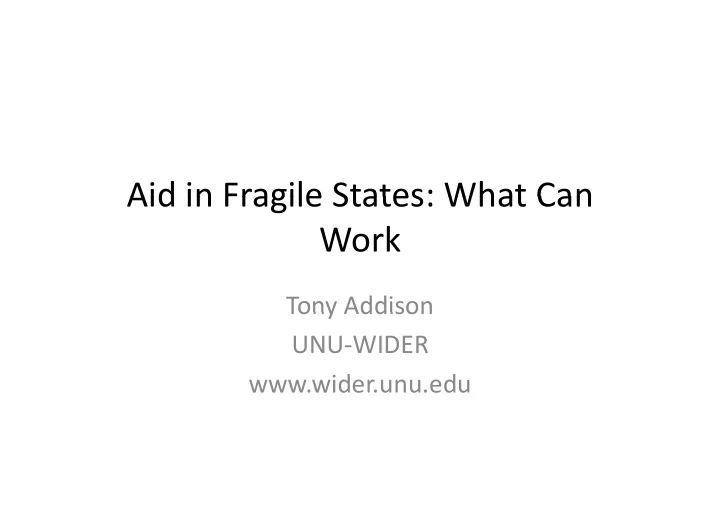

Aid in Fragile States: What Can Aid in Fragile States: What Can Work Tony Addison Tony Addison UNU-WIDER www.wider.unu.edu
Context Context • Fragile states have very mixed characteristics • Some are large aid recipients, some receive Some are large aid recipients, some receive very little • What they have in common: donors find them Wh h h i d fi d h tough to work with • Weak governance & weak implementation capacity dominate discussion of fragile states capacity dominate discussion of fragile states
The Gordian Knot The Gordian Knot
The Gordian Knot The Gordian Knot • Economic growth – cutting through the tangled knot of fragility & its politics g g y p • If aid promotes growth, and growth promotes peace then aid delivers a ‘double dividend’ peace, then aid delivers a double dividend • Growth can achieve much – not least by delivering rising domestic revenues • To build states & reduce social (ethnic) • To build states & reduce social (ethnic) inequalities via pro-poor spending
Public Finance & Service Delivery Public Finance & Service Delivery • Crucial to distributing the fruits of growth C i l t di t ib ti th f it f th • Poverty-reducing expenditure as a share of domestic revenue doubled in Uganda & domestic revenue doubled in Uganda & Mozambique, rose by a half in Ethiopia (99-06) • Resource rich fragile states: poverty reducing • Resource-rich fragile states: poverty-reducing expenditures stagnant (e.g. Guinea) • Of the 8 countries whose real GDP per capita rose • Of the 8 countries whose real GDP per capita rose by more than 50% over 1997-07, only 1 was non- fragile & 5 of the 8 were resource-rich g • Innovation in disbursement – e.g. AusAid working with churches in fragile states in Pacific g
Growthis both Stabilizing & Destabilizing • Conflict & instability in Kenya, Madagascar & (northern) Uganda followed strong growth • Pakistan has achieved strong growth – but now a failing state? now a failing state? • Naxalite insurgency in India – despite (or because of) strong growth because of) strong growth • Gujarat (India) highest growth of all Indian states but worst communal violence b l l • ‘Arab Spring’ today after a decade of growth p g y g
Quality of Growth Quality of Growth • High unemployment + high inequality is a • High unemployment + high inequality is a combustible mix, growth or not • High spatial inequalityeven in success stories – h l l Uganda (fall in overall poverty rate) • Building growth around the poor – strengthens the INTERNAL engine of growth the INTERNAL engine of growth • e.g. Guatemala vs. El Salvador: both Post-Conflict. Social protection in El Salvador (part aid Social protection in El Salvador (part aid- financed) cut poverty. Guatemala: stagnation • BUT internal growth engine not enough
Engagement with the Global Economy Engagement with the Global Economy • Fragile economies – mostly small (small il i l ll ( ll populations & low per capita income) • 19 out of the 35 fragile states on the DFID list have populations of 10 mn or less • Post-war growth bounce stimulates domestic demand & the internal growth engine • but even if Sierra Leone (fragile) doubled its per capita income, its economy would still be less p , y than one-quarter the size of (non-fragile) Tanzania (which is small economy, globally) y g y
The Missing Middle The Missing Middle • Middle-classes are thin – most people are poor a Middle classes are thin most people are poor, a few are very wealthy in fragile states • This MISSING MIDDLE is inter twined with • This MISSING MIDDLE is inter-twined with another missing middle (lack of small & medium- sized enterprises) sized enterprises) • Impetus for democratization is therefore weak + job creation is weak job creation is weak • What to do? Look to the diasporas – with their k knowledge of global value chains + their capital l d f l b l l h i th i it l • Example of Success: Uganda’s Asians
Conclusion Conclusion • What Works, What Might Work h k h i h k • Focusing aid & technical assistance on building g g public finance (Success: Uganda, Mozambique, Ethiopia, Rwanda) q , p , ) • Innovation in service delivery (AusAid in Pacific) Pacific) • Social Protection (El Salvador) • Encouraging the return home of diasporas capital (Uganda & maybe North Africa)
Recommend
More recommend